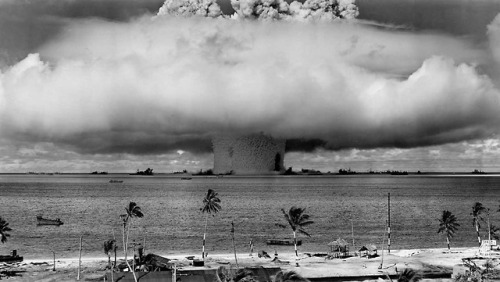A nuclearexplosion test, codenamed “Baker”, part of Operation Crossroads,at Bikini Atoll in the Mars
A nuclearexplosion test, codenamed “Baker”, part of Operation Crossroads,at Bikini Atoll in the Marshall Islands (July 25th, 1946).The second photo shows the white surface “crack” under the ships, and the top of the hollow spray column protruding through the condensation cloud. In the background is Bikini Island beach.The 40-kilotonatomic bomb was detonated 3.5 miles from Bikini Atoll, at a depth of27m below the ocean surface. The purpose of Crossroads tests was tostudy the effects of nuclear explosions on ships. They would be thefirst of many nuclear tests held in the Marshall Islands, and thefirst to be publicly announced beforehand and observed by an invitedaudience, which included a press corps.95 targetvessels were assembled in Bikini Lagoon, with amphibious target shipsberthed on Bikini Island. At the centre of this target cluster, thedensity was 20 ships per square mile, or 7.7 ships per squarekilometre, which was 3-5 times greater than military doctrineallowed. The goal was to measure damage at various distances fromthe blast centre (as many different distances as possible).The Army andthe Navy had disagreed about how many ships should be allowed tosink. The target fleet included four obsolete US battleships, twoaircraft carriers, two cruisers, 11 destroyers, 8 submarines, manyauxiliary & amphibious vessels, and three surrendered German &Japanese ships, including the Japanese battleship Nagato.The shipscarried sample quantities of fuel & ammunition, and scientificinstruments to measure air pressure, ship movement and radiation. The support ship USS Burleson supplied live animals for some of thetarget ships – there were 204 goats, 200 pigs, 200 mice, 60 guineapigs, and grains containing insects. These animals would be studiedfor genetic effects by the National Cancer Institute.USS LSM-60, alanding ship from WW2, was placed in the centre of the target fleetwith the bomb suspended beneath it. Baker was detonated 27munderwater, halfway to the ocean floor, which was 55m deep. The bombhad a yield of 23 kilotons. No identifiable remains of LSM-60 haveever been found: it was probably vaporized by the nuclear fireball.So many unusualphenomena were produced by the Baker explosion that two months later,a conference was held in order to standardize nomenclature and definenew terms to use in description and analysis.The underwaterfireball was in the form of a rapidly-expanding hot gas bubble. Itpushed against the water, creating a supersonic hydraulic shock wavethat crushed the hulls of nearby ships as it spread outwards. Whenthe bubble’s diameter had expanded to the water’s depth (i.e. 55m),it hit the ocean surface and floor at the same time, 4 millisecondsafter detonation.At the oceanfloor, it began digging a shallow crater, which was ultimately 9mdeep and 610m wide. At the ocean surface, it pushed the water aboveit into a “spray dome”, which burst through the surface like ageyser.When the bubblereached the air, it set off a supersonic atmospheric shockwave, whichwas (like the “crack”) more visually dramatic than destructive. Behind the shockwave was a short-lived area of low pressure, whichcaused fog to instantly develop, shrouding the developing column in acondensation cloud, obscuring it from view for two seconds. The condensation cloud started out hemispherical and expanded into adisk, which then lifted up from the water, revealing thefully-developed spray column, then expanded into a doughnut andvanished.There weredecontamination problems with the Baker test. Because of this, theUS Navy equipped new ships with the CounterMeasure WashDown System, aset of pipes & nozzles that would cover the ship’s exteriorsurfaces with a spray of salt water whenever nuclear attack seemedimminent. In theory, the film of flowing water would prevent nuclearcontaminants from settling into cracks and crevices. -- source link
Tumblr Blog : mostly-history.tumblr.com
#history#nuclear power#nuclear warfare#geography#meteorology#physics#medical history#usa#marshall islands#bikini atoll#nagato#uss burleson#uss lsm-60#condensation cloud#cancer

